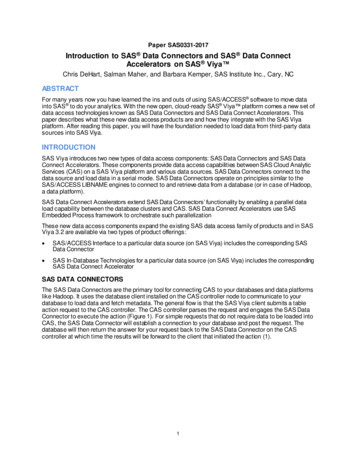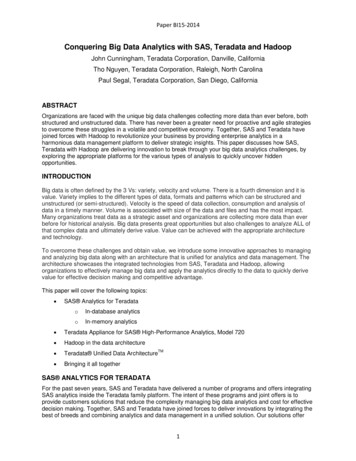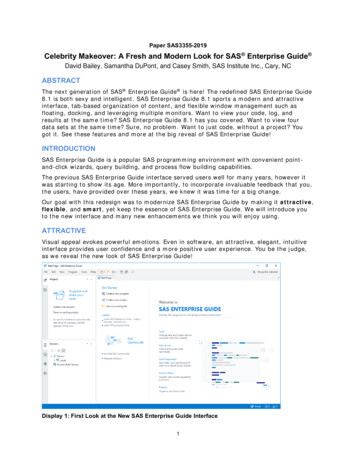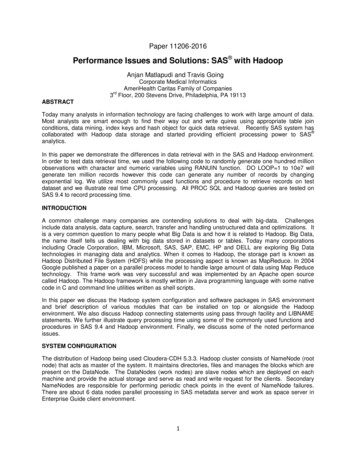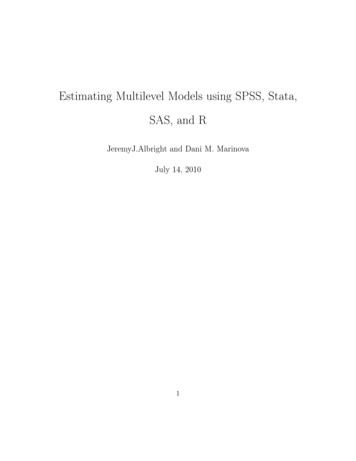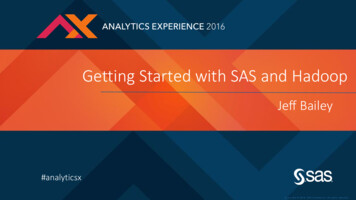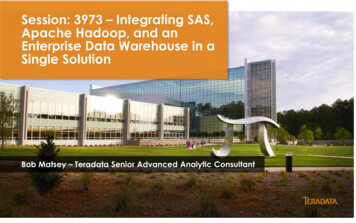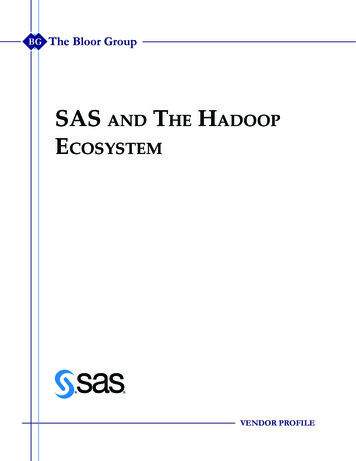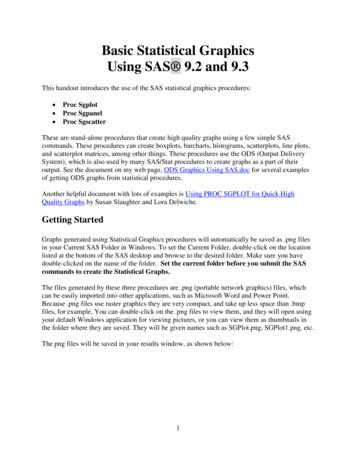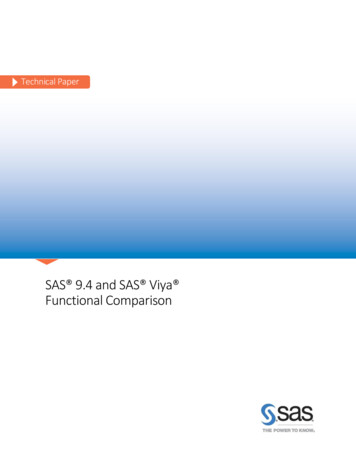
Transcription
Technical PaperSAS 9.4 and SAS Viya Functional Comparison
Release InformationContent Version: 3.5 January 2020Trademarks and PatentsSAS Institute Inc., SAS Campus Drive, Cary, North Carolina 27513.SAS and all other SAS Institute Inc. product or service names areregistered trademarks or trademarks of SAS Institute Inc. in the USA andother countries. indicates USA registration.Other brand and product names are registered trademarks or trademarksof their respective companies.
ContentsSAS 9.4 and SAS Viya Functional Comparison .1SAS Platform . 1SAS Foundation . 2Distributed Processing . 3User Interfaces and Program Development . 3Administration . 4Operating Environments . 4Multi-tenancy . 5Platform Summary . 5Related Product Offerings . 6Analytics Life Cycle . 7Data Management . 8Visualization . 12Data Mining / Machine Learning . 14Econometrics . 17Optimization . 17Forecasting . 17Text Analytics . 20Visual Statistics . 22Model Management. 22Decision Management . 23i
SAS 9.4 and SAS Viya Functional ComparisonSAS PlatformThe SAS Platform comprises the software components that underpin SAS product offerings in analytics, datamanagement, and visualization. These components provide support for foundational capabilities such as distributedprocessing, security, administration, program development and execution, resource management, user interfaces, aswell as integration with cloud environments, operating systems and third-party software. SAS 9.4 and SAS Viyacontribute software components that can be integrated into a unified SAS Platform.Although SAS 9.4 and SAS Viya represent two engines that support a common SAS Platform, it’s helpful to comparethe functional approaches delivered by each. Understanding these respective approaches will help you optimize theSAS Platform for your specific business needs by leveraging the engine or engines that make the most sense. SASproducts have been developed to take advantage of both engines, and in many cases, you will find equivalent productfunctionality in both engines. This document highlights the similarities and differences between the engines and theproducts that leverage them.Starting with the SAS 9.4M5 release (September 2017), SAS 9.4 programming clients could take advantage of a SAS Cloud Analytics Services (CAS) server in a SAS Viya environment. This means that, in most cases, you do not haveto choose between the two engines. You can use a single SAS 9.4 client such as SAS Studio, SAS EnterpriseGuide, SAS Data Integration Studio, Display Manager System (DMS), or even a batch program to execute SAS 9.4code that uses a SAS 9.4 server, and SAS Viya procedures that use a CAS server, all within the same program.Because SAS Viya deployments include a full SAS programming run-time environment, they can provide similarsupport to developers without the need for a separate SAS 9.4 environment. A SAS Viya client can execute both SAS9.4 code in the SAS programming run-time environment and SAS Viya procedures using a CAS server.The following diagram depicts the relationship between SAS programming clients and execution engines. All SASprograms are initially submitted to either the SAS 9.4 engine or SAS programming run-time environment engine. AnySAS Viya procedure that is encountered by either engine is executed in the SAS Viya CAS server.1
SAS FoundationAt the core platform level, functionality is shared between SAS 9.4 and SAS Viya. First and foremost, both enginessupport the full complement of Base SAS . This means that SAS 9.4 programs can run unmodified within a SAS Viyaclient session. In a SAS Viya environment, some of the Base SAS procedures can take advantage of a CAS server,and others simply run on a traditional SAS Foundation server. You can find a list of CAS-enabled procedures in theSAS 9.4 and SAS Viya 3.4 Programming Documentation: Base SAS Procedures Guide. In addition, the DATA stepitself is CAS-enabled and can therefore take advantage of distributed processing for faster execution times. Care mustbe taken in converting existing DATA step code to run in CAS because splitting execution across multiple CAS serverworker nodes can result in changes in behavior of automatic macro variables, which previously assumed singlethreaded execution. Programmers are encouraged to read Steven Sober’s 2018 SAS Global Forum paper entitled MyExperiences in Adopting SAS Cloud Analytic Services into Base SAS Processes for more detail. You can also view arecorded presentation on this topic entitled Leveraging SAS Viya to Improve Base SAS Processes oncommunities.sas.com.Other SAS Foundation products such as SAS/STAT , SAS/GRAPH , SAS/ETS , and SAS/OR are fully supportedin a SAS Viya environment when they are included in related product offerings. Other SAS Foundation products,such as SAS/IML , SAS/QC , and many SAS/ACCESS interfaces are available as add-on products to a SAS Viyaorder. Therefore, SAS Viya users have access to both the distributed computing capabilities of the SAS Viyaproducts and the functionality of the included SAS Foundation products. You can run your new SAS Viya code aswell as your existing SAS code in your SAS Viya environment, which can access both the SAS Foundation serverand the CAS server.The way in which SAS Foundation code is executed varies according to the clients that are used in a SAS 9 andSAS Viya environment. With SAS 9, both desktop clients (such as SAS Enterprise Guide and SAS Add-In forMicrosoft Office) and web clients (such as SAS Studio) submit code to a SAS object spawner that then routes the job2
to an appropriate workspace server or to a stored process server. With SAS Viya, such requests are typicallysubmitted to a launcher server, which then routes the job to an appropriate compute server. The binary files thatsupport the compute server execution are analogous to a SAS Foundation V9 installation and are referred to as theSAS programming run-time environment. These files are stored in the spre directory of your SAS Viya installation.Although SAS Studio 5.x uses the launcher server method with SAS Viya, SAS Studio 4.x, which is the default SASprogramming client for SAS Viya 3.3 and earlier, uses the SAS object spawner method.Distributed ProcessingPerhaps the most significant core platform functional difference between SAS 9.4 and SAS Viya is in the way that eachone handles distributed processing. SAS Viya leverages the CAS server, and SAS 9.4 uses SAS LASR , SAS HighPerformance Analytics (HPA) and SAS Grid Manager. Even though SAS LASR and HPA will remain only in SAS9.4, SAS Grid Manager functionality will eventually be ported to SAS Viya environments (targeted for 2020). Becausethe CAS server is the third major evolution of the SAS distributed in-memory technology, it is no surprise that it offersthe most value. Compared to HPA, the CAS server performs better because it can retain data from one action to thenext action rather than having to reload the same data from disk for each action. In comparison to both HPA and SASLASR, the CAS server offers dynamic scalability, a virtual memory footprint, high availability, parallel data loading,shared library access, and integration with open-source languages and REST APIs. SAS Grid Manager in a SAS 9.4environment can work in concert with a SAS Viya environment. “The grid” distributes multiple SAS 9.4 jobs frommultiple users across a cluster of machines, and each job can be further parallelized with the DATA step and SASprocedure code executing across multiple worker nodes in a CAS server that is running in a companion SAS Viyaenvironment.User Interfaces and Program DevelopmentAlthough SAS 9.4 clients use a variety of interfaces, such as Java clients like SAS Enterprise Miner, .NET clients likeSAS Enterprise Guide, and web clients like SAS Visual Analytics, SAS Viya clients all use a common HTML5 webinterface. This common interface allows for all functionality to be merged into a single user experience. SAS 9.4provides a launching page for certain web clients that is known as SAS Home. This dashboard supports launchertiles that are specific to the associated SAS products. SAS Viya provides a dashboard for all its web clients calledSAS Drive. This dashboard is oriented toward the user more than is SAS Home, enabling users to view, edit, andshare content associated with their licensed SAS Viya products.SAS Viya has a single interactive development interface for SAS code – the SAS Studio web application. SAS 9.4has several interfaces, including SAS Studio (a different version from the one delivered with SAS Viya), SASEnterprise Guide, Display Manager System (DMS), and the Code Editor in SAS Data Integration Studio. SAS Studio5.2 (delivered with SAS Viya) provides some unique features but does not yet provide full replacement value for allthe capabilities that are provided by SAS Studio 3.x (delivered with SAS 9.4). For example, SAS Studio 5.2 cansave programs to the local file system as well as the SAS Infrastructure Data Server, and SAS Studio 3.x can saveprograms only to the local file system. Such an approach lends itself more readily to cloud deployments. On theother hand, SAS Studio 3.x provides support for the management of process flows, which remains to be delivered ina future release of SAS Studio 5.x. You can find an up-to-date feature comparison of the different versions of SASStudio (and SAS Enterprise Guide) in SAS Studio’s Help Center.Both SAS 9.4 and SAS Viya support batch execution of SAS code as well as integration with open developmentenvironments such as Jupyter Notebook. This integration includes execution of SAS code as well as the generation3
of SAS code from Python calls. The SASPy project, which is available on GitHub, provides this native Pythoninteroperability for both SAS 9.4 and SAS Viya. For SAS Viya, you can also use the SAS Scripting Wrapper forAnalytics Transfer (SWAT) Python package to call CAS server actions directly, skipping the translation layer. In fact,because the CAS server allows for direct calls from Python, R, Java, Lua, and REST APIs, you can use anyintegrated development environment that supports these languages. Furthermore, you can call analytic functionsthat are provided by these alternative languages within SAS Visual Data Mining and Machine Learning jobs.Models created using these languages can be imported and managed using SAS Model Manager, which allows forease in using ensemble modeling methods.SAS 9.4 has rich support for stored processes, which allow for SAS programs to be defined and executed interactively,either through the SAS Stored Process web application, directly from a URL, or via clients such as SAS EnterpriseGuide. A prompting framework is provided to support arguments that are passed to these programs at run time. Suchprograms can also be run in batch and can always take advantage of the SAS Stored Process Server. SAS Viya usesjob definitions to manage such code and provides functionality in SAS Studio 5.2 to define these programs. See SASStudio 5.2 Developer’s Guide: Working with Jobs for more details.AdministrationSAS 9.4 has several utilities to perform administrative functions: SAS Environment Manager, SAS ManagementConsole, SAS Visual Analytics Administrator, and SAS Deployment Manager. For SAS Viya, all this functionalitywas collapsed into a single web application: SAS Environment Manager. For SAS Viya, SAS Environment Managerwas totally rewritten. The only thing it shares with its SAS 9.4 counterpart is its name. The SAS EnvironmentManager interface for SAS 9.4 provides a rich set of near real-time reports about various process and systemmetrics as well as an advanced event handling interface. The SAS Environment Manager interface for SAS Viyaprovides similar metrics and reporting capabilities as the SAS 9.4 application but does not yet have as complete aset of real-time reports. Both environments supply a back-end data mart that contains historical metric and logginginformation for user-developed reports. SAS Viya adds an event-driven operations infrastructure to the mix, withcommand line interface (CLI) access to a real-time message bus that can be integrated with third-party monitoringapplications.Another key administrative difference between SAS 9.4 and SAS Viya is that the former uses the SAS MetadataServer to persist and manage data about your environment, including server and library definitions, security, usercontent, and configuration information. SAS Viya persists much of this information in the new SAS InfrastructureData Server (based on PostgreSQL) and SAS Configuration Server (based on Consul). Another importantdistinction is that although SAS 9.4 uses identities from the SAS Metadata Server to define users and groups, SASViya leverages pre-existing customer directory services that are LDAP-based, such as Microsoft Active Directory.The advantage of SAS Viya is that administrators do not have to worry about keeping their SAS identities in syncwith their LDAP identities as they do with SAS 9.4.Operating EnvironmentsSAS 9.4 can be installed on a variety of operating systems, including z/OS and several flavors of Windows, UNIX,and Linux. SAS Viya can be installed on a Linux or Windows Server. SAS Viya on Windows is limited to SAS VisualData Mining and Machine Learning, SAS Visual Statistics, and SAS Visual Analytics. It is also limited to singlemachine environments in which the CAS server and all other supporting servers and services are installed on thesame physical or virtual machine. Both SAS 9.4 and SAS Viya can be deployed to a public or private cloud, which4
can be used as an Infrastructure-as-a-Service (IaaS).In addition, SAS provides deployment automation scripts that are native to certain public cloud providers. Forexample, a SAS 9.4 SAS Grid Manager reference deployment is available as the SAS Grid on AWS Quick Startdeployment script. A reference deployment containing SAS Visual Data Mining and Machine Learning, SAS VisualStatistics, and SAS Visual Analytics is available as the SAS Viya on AWS Quick Start deployment script. A similaroffering is available for Microsoft Azure’s Resource Manager as the SAS Viya Quickstart Template for Azure.SAS is increasingly adopting strategies using Docker containers and Kubernetes orchestration to provide morecomposable, scalable, and maintainable deployments. The SAS Analytics for Containers offering for SAS 9.4provides customers with a way to build and deliver a SAS Analytics Pro environment (for example, an environmentthat includes Base SAS, SAS/GRAPH, SAS/STAT, and SAS/ACCESS) as a Docker container. SAS Viya providessupport for both pre-built Docker images as well as Docker recipes for building your own containers. Recipes forSAS Viya containers are maintained on GitHub. SAS Cloud Software as a Service (SaaS) offerings of select SASViya products use Kubernetes to more easily orchestrate complex container-based deployments.Multi-tenancyBoth SAS 9.4 and SAS Viya provide support for separating processing and data and allocating them to “tenants,” suchas different customers, departments, or levels of a deployment (for example, DEV [development], TEST, and PROD[production]). With SAS 9.4, multi-tenancy can be accomplished by allocating different SAS application servers todifferent tenants, which locks their use and their access to data based on membership in groups that are associatedwith the respective tenants. SAS Grid Manager offers increased support for multi-tenancy, enabling advancedallocation of compute resources among tenants. SAS Viya environments can be configured to handle tenants in thesame fashion as SAS 9.4, using authorization settings and separate SAS and CAS run-time environments for eachtenant. SAS Viya also offers a more explicit form of multi-tenancy out-of-the-box, which relieves the administrator ofthe burden of resource isolation and provides even more separation between tenants. In a true SAS Viya multi-tenantdeployment, tenants are essentially given separate environments, with each tenant having no awareness of the others.A single provider tenant is used to manage all the other tenants, each of which has its own separate servers, usercontent, and web application entry points. Each tenant can also be configured to point to a different LDAP server forassociated users and groups. A common set of services is used to support the entire multi-tenant environment,allowing for economy of scale in administrative functions such as software updates and horizontal scaling.Platform SummaryThe following table summarizes the similarities and differences between certain core platform functionality in SAS 9.4and SAS Viya deployments.5
CategorySAS FoundationDistributed ProcessingInterfacesCapabilityBase SASMulti-threaded DATA step executionExtended data typesSAS/GRAPH, SAS/STAT, SAS/OR, SAS/ETS, SAS/IML, SAS/QCSAS Grid ManagerSAS LASRSAS High Performance AnalyticsCAS serverBatchSAS StudioSAS Enterprise GuideSAS 9.4M6SAS Viya 3.4aaa(VARCHAR)aaaaaaaa1aaaaOpen programming languages (Python, Java, R, Lua)2REST APIsSAS Application DevelopmentAdministrationOperating Environments for ServersaaaaaaSAS Stored Processes3Job definitionsLDAP integration for users and groupsMonitoring and reportingAuditingCLIsLinuxaWindowsSolaris, HP, AIXz/OSCloud - IaaSCloud - PaaS (Cloud Foundry)Docker containersaaaaaaaaaaaaaaaa4aaaNote: A gray checkmark (a) means that the capability is possible if both SAS 9.4 and SAS Viya are present.1Product availability based on licensed SAS Viya offering(s), not all of which are available on Windows2Some Python capability is available for SAS 9.4 through the SASPy GitHub project3SAS 9.4 stored processes can be accessed from SAS Viya reports.4Single machine deploymentsRelated Product OfferingsMany SAS Viya product offerings have counterparts in SAS 9.4. In many cases, the SAS Viya Customer AdvantageProgram can provide significant financial benefit to existing SAS 9.4 customers who license related SAS Viya offerings.The following table summarizes these related offerings.SAS 9.4 OfferingSAS High-Performance Data MiningSAS Enterprise MinerRelated
functionality in both engines. This document highlights the similarities and differences between the engines and the products that leverage them. Starting with the SAS 9.4M5 release (September 2017), SAS 9.4 programming clients could take advantage of a SAS Cloud Analytics Services (CAS) server in a SAS Viya environment.

